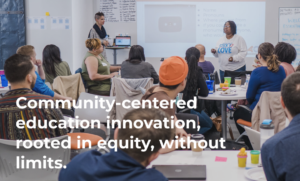Design Thinking: A Human-Centered Approach to Innovation in Education

By: Sandy Speicher
Talk to any educator, parent, or policy maker and you will inevitably hear about the many problems that exist in education. It’s not for lack of trying – millions of people are working across the country to find new solutions for our schools. And yet we’re struggling to find new answers that make a real difference. As Einstein famously said, “We can’t solve our problems by using the same kind of thinking we used when we created them.” We tend to think first about the needs of the system and create solutions from there. But what if we looked first to the needs of people, and then designed ways the system could meet its goals by serving these needs? This is the heart of how design thinking gets to innovative solutions.
Recently IDEO, the design and innovation firm where I work, collaborated with San Francisco Unified School District to develop a new vision for their food system. Instead of starting from a typical approach to food system reform – auditing equipment, aligning policies – we started by thinking about the students. What do they care about? What would engage them in choosing the healthy meals SFUSD already offers them? And then how might we realign finances, operations and labor to create experiences kids would want?
Through interviews, observations and workshops, we engaged hundreds of people, including students, parents, union leaders, nutritionists, teachers, and community groups. We learned so much about today’s kids – how many different taste palettes they represented, how desperate they were for time to connect with friends, how engaged they were with food outside of school (from cooking to blogging), and how much they were craving information to help them be responsible about food. Thus, our solutions included expanded food choices, eliminated long lines, and added more places to get food. We also designed a technology platform that allows students to order food, give feedback, and manage their nutrition and budgets… which of course, helps the system be more efficient and effective. Ultimately, our recommendations balanced an understanding of today’s students with the realities of budgets, staffing, and local and Federal regulations.
As part of this collaboration, we prototyped our ideas with students. In one particularly revealing moment, a student told us what she thought about the new lunchtime experiences: “I love this so much. This would be amazing. I just can’t believe you would do this for us.”
Her words sound simple, but stop and think. Every day people show up at work in our schools because they care deeply about our kids. Yet we often end up designing experiences that don’t actually meet these kids where they are. We unintentionally turn them off. So much so that they don’t believe we would design something that they would actually like.
Without even realizing it, we bias what we create in education to the needs of the system. We start with policy, regulations, and the outcomes we desire, and assume that those conditions dictate the way things should happen in education. Often it is that very thinking that gets in the way of creating experiences that engage today’s youth. What if we took a human-centered approach to the design of our schools, tools and systems? People, and our understanding of them, are the heart of innovation.
Every parent, teacher, administrator, EdTech developer, and policy-maker I have met has been aligned on one thing: everyone wants what’s best for our children. Few, however, are aligned on what that means we should be doing. There are so many reasons for this, but in focusing on the politics, policies, or even the norms of the past, we may overlook some of the deep emotional challenges that we feel as we try to evolve education locally and nationally. We have all grown up in an education system and that system helped form who we are, what we value, and the way we understand how learning happens. It’s the water we swam in for many years of our lives, and it’s hard to realize that there’s any other way it could be. In fact, everything about our schools has been designed. And it can, and should, be re-designed to answer the evolving needs of our times.
Designing with an understanding of people’s needs and desires – what design thinking is all about – doesn’t mean we compromise the system’s desired outcomes. Rather, the design process takes the aspirations of a system and seeks ways we can achieve these outcomes through experiences that people actually want. If we really want to innovate in education, we must let go of our assumptions about how schools work, and open up to what really understanding our students can teach us about what we should be creating.
 Sandy Speicher is an Associate Partner at the global design and innovation firm IDEO. She is the Managing Director of IDEO’s Education practice, which looks to people’s unmet needs, desires, and aspirations to inspire new solutions for a wide variety of challenges—from the ways that people are learning to the ways that systems are operating.
Sandy Speicher is an Associate Partner at the global design and innovation firm IDEO. She is the Managing Director of IDEO’s Education practice, which looks to people’s unmet needs, desires, and aspirations to inspire new solutions for a wide variety of challenges—from the ways that people are learning to the ways that systems are operating.







Laura Archuleta
I love the idea of a human-centered approach and I can see how asking the right questions can lead to better answers for our schools and our students. I especially like the question,"what if we looked first to the needs of people, and then designed ways the system could meet its goals by serving these needs?". So often it seems that the system works in a certain way and the students and their needs have to find a way to fit within that model, rather than the other way around. I'd love to see schools go first to student need, and then build a system around them. If any schools are doing it that way and having success, I'd love to hear about it!
Guillermo Garza Milling
Excellent.
I like to mention that, to be open to try the off the wall Ed initiatives, Schools districts, at least, must have an open experimental lab.
My initiative The Knowledge Labyrinth is looking for an open door.
Victoria Bergsagel
LOVE, love, love this statement Stacy. "We start with policy, regulations, and the outcomes we desire, and assume that those conditions dictate the way things should happen in education. Often it is that very thinking that gets in the way of creating experiences that engage today’s youth. What if we took a human-centered approach to the design of our schools, tools and systems? People, and our understanding of them, are the heart of innovation." Thanks.
Adam Nathan
This is an inspiring framework for driving human-centered innovation in K-12. Sandy, I'm curious if you have done any work on how data initiatives might leverage this human-centered approach to design. If there's been work in this space, I'd love to learn more about the connection to analytics.